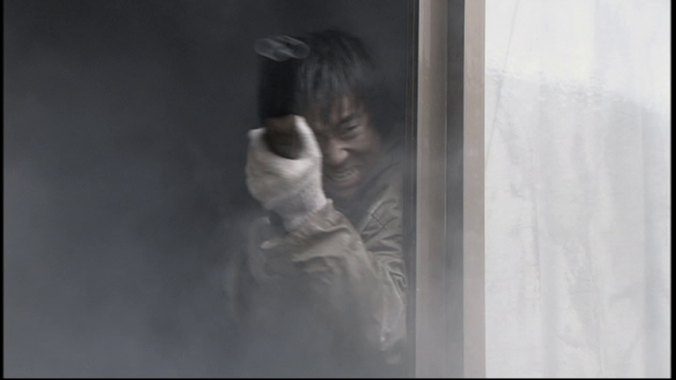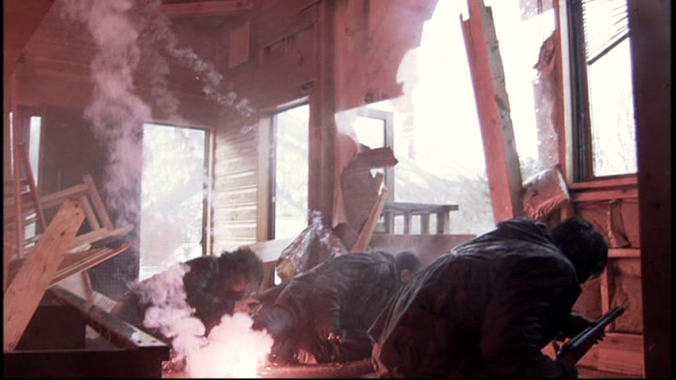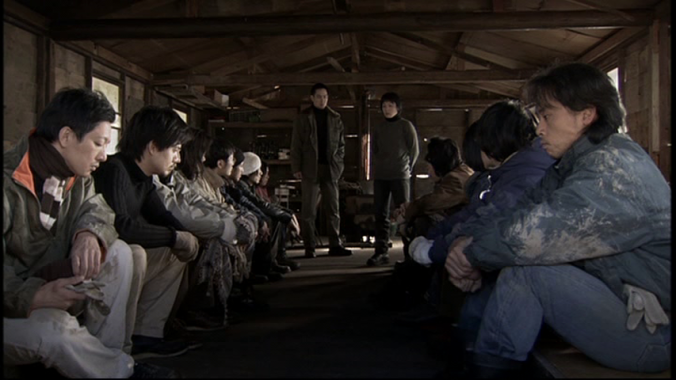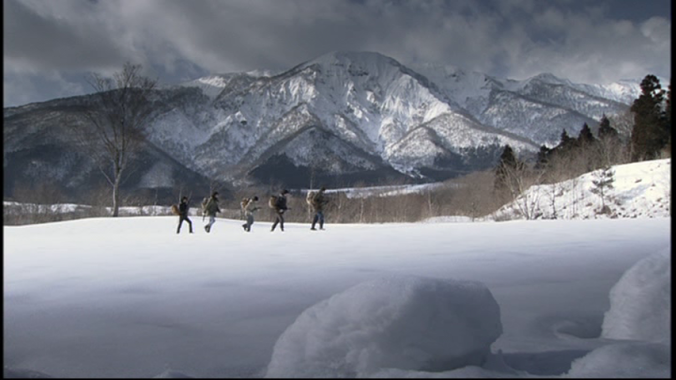 The Asama-Sanso Incident in 1972, covered live on national TV, essentially ended the student rebellions of the sixties. After a days long standoff involving several gunshot deaths, police stormed a mountain ski lodge, rescued the housekeeper, and arrested the last members of the United Red Army. The story had been told from the view of the police outside in Choice of Hercules, but Koji Wakamatsu’s United Red Army tells the story from the inside. At over three hours in length, it is a dissection not so much of the siege itself but of the student movements that led up to it.
The Asama-Sanso Incident in 1972, covered live on national TV, essentially ended the student rebellions of the sixties. After a days long standoff involving several gunshot deaths, police stormed a mountain ski lodge, rescued the housekeeper, and arrested the last members of the United Red Army. The story had been told from the view of the police outside in Choice of Hercules, but Koji Wakamatsu’s United Red Army tells the story from the inside. At over three hours in length, it is a dissection not so much of the siege itself but of the student movements that led up to it.
As such, it breaks into three parts. The first is an extensive documentary look at the rise of the left-wing movements, beginning with the student protests against the ANPO Treaty in 1960. Narrated by Yoshio Harada and using a mix of brief scenes and newsreel footage, it shows how the government’s insistence on adopting the new treaty with the US, despite enormous public opposition, gradually morphed into what the government (and the US) had feared most, an alliance of student protesters and radical, militant Communists. This is a long slog, for American viewers at least, because there is a profusion of organizational names and of characters who may or may not become important later. However, it serves as a reminder of the whole range of sixties protests across the world and how they were inseparably tied to the US war in Vietnam and to the Palestinian resistance to the formation of a Jewish state in Israel. It also serves as an explanation for a younger Japanese audience of events that have become a part of their distant past.
The third section depicts the siege itself, dealt with crisply and confined to the inside of the mountain hotel, with no views of the police outside except an occasional glimpse of a helicopter.
The bulk of the film, however, is the grueling period in between, after two of the various groups decided to join together as the United Red Army. They retire to a cabin in the mountains, ostensibly to undergo military training, but this soon turns into a purification of the group. By this time, the official Communist Party connected to the Soviet Union had formally expelled the two militant wings, who have chosen to follow in the path of Mao’s Cultural Revolution, requiring the elimination of all bourgeois attitudes through constant self-criticism sessions. At first these are humiliating, but under the constant pressure from Tsuneo Mori, leader of the Red Army Faction, and Hiroko Nagata, head of the Revolutionary Left Faction, they grow more intense. Those who need a “self-critique” are beaten by the other members to help them reach a true understanding, until a number are actually beaten to death and others are tied up outside after their beatings where they freeze to death in the snow, eventually leading to twelve deaths. An additional two members who had tried to leave the group earlier were tracked down and “executed” even before the group left for training.
Those who need a “self-critique” are beaten by the other members to help them reach a true understanding, until a number are actually beaten to death and others are tied up outside after their beatings where they freeze to death in the snow, eventually leading to twelve deaths. An additional two members who had tried to leave the group earlier were tracked down and “executed” even before the group left for training.
The most grueling of these beatings comes when Nagata accuses Mieko Toyama of bourgeois tendencies because she has brought lipstick with her to the mountains. Toyama had been a founder of the RAF, so her selection is the ultimate sign of the organization eating its own. She is forced to beat her own face to a pulp, then tied to a post and starved to death.
Two other women are selected because they got permanents, a man is chosen because he spoke to policemen bringing him food while he was in jail, and two others are attacked because they went to a public bath while on a mission to buy food in town. One woman, eight months pregnant is also beaten to death, though we are shown only the body.
A few manage to escape, which causes the group to break up in case the police are informed of their whereabouts. They are supposed to meet at a cave, but somehow Mori and Nagata don’t make it and are eventually arrested together in Tokyo. When it becomes clear the nine remaining have been found by the police helicopters, they break into two groups, one of which is soon arrested waiting for a train while the other, struggling through a blizzard, wind up at Asama Lodge.
Even there, the urge for purity can’t be resisted. When one man is seen eating a cookie, the group’s leader demands a self-critique even while the police surround the building.
Wakamatsu had been one of the pioneers of the pinku film, but also one of the most imaginative, and many of these had a political edge to them, particularly about opposition to Japan’s close alliance with America. For a while, he had been friends with Oshima, sometimes shooting his pink films side by side with Oshima on location. He had also been close friends with Masao Adachi, who wrote some of Wakamatsu’s movies and who was a member of the Japanese Red Army. However, Adachi had not been a part of the Asama Incident, for he had followed Fusako Shigenobu, whom we see leaving her best friend after getting married only to get on her husband’s family register to obtain a passport. She goes to Lebanon, where several other members of the group eventually gather and from where the Japanese Red Army engineered a number of famous terrorist incidents.
In Night and Fog, Oshima had depicted the collapse of the leftist student organizations, blaming it on leaders who have returned to the safe bourgeois background in which they had lived before they entered college, and had essentially washed his hands of the entire leftist movement. Now, decades later, Wakamatsu has used the Asama incident to show not only how the Japanese leftists had failed but also how similar movements had fallen apart from within. One of the last bits of news the besieged receive before the power is turned off is Nixon’s arrival in China. Their self-criticism sessions had obviously been modeled on those of the Cultural Revolution in China, when students had effectively taken over the country to purify it of all bourgeois tendencies. Now, all their efforts to start a great world-wide uprising seem to have been in vain, since even Mao would talk to the greatest symbol of American Imperialism.
Now seventy, Wakamatsu really wanted to make this movie. He used his own home for the interiors of the lodge, ultimately destroying it completely. Though he plays “Le Temps des cerise,” the song of the Paris Commune, ever so quietly in the background as things are falling apart for the last survivors, there is nothing nostalgic about the presentation itself. The Japanese title is The True Story and Wakamatsu never tries to put a golden glow on the activities, nor does he try to make them villains. Whatever dreams the original members may have had, now they are destroying themselves from within in their quest for ideological purity. For the most part United Red Army is brilliantly directed, for his decades on the limited budgets of the pinku film had taught him well about how to use confined spaces to maximum effect.  The mountain exteriors demonstrate an eye that was rarely given opportunity in his earlier films, though I have begun to think that it is almost impossible for anyone to shoot a movie in the Japanese mountains without producing moments of great beauty.
The mountain exteriors demonstrate an eye that was rarely given opportunity in his earlier films, though I have begun to think that it is almost impossible for anyone to shoot a movie in the Japanese mountains without producing moments of great beauty.
Wakamatsu uses a cast of relative unknowns in their early twenties, but the performances are uniformly excellent. Despite the constant demand for self-critique, we never see behind Mori and Nagata. After the arrest of the original group leader, Mori has pushed himself into the leadership simply by being the loudest voice. By the time they go into training, he has become the one who decides what is pure thought and who needs to undergo self-criticism, and the group acquiesces, partly because they are in agreement and partly, as the sessions continue, because they are afraid. He talks almost completely in the repetitive jargon of modern communism but seems to believe what he is saying. Though a small woman, Nagata was one of the greatest advocates for violence from the beginning. Neither quite seems evil, but there does seem to be more than a whiff of jealousy about Nagata as she eventually attacks all of the women. Though there have been sexual relationships among the group, this is no hippy commune; Nagata has been the lover of one of the men who ends up at the Lodge, but as the group breaks up to meet later she chooses to leave him for Mori* when Mori goes to Tokyo to raise funds.
Only the first section seems a bit amateurish, at times looking like one of those TV “documentaries” that also use re-enactments to liven up the narration. Unfortunately, this is the first section, so many viewers may decide to give up, overwhelmed by the number of faces and incidents. But once you make it past that, when we begin to see the people more clearly, it is a powerful and fascinating film.
* Mori would eventually commit suicide in prison before his trial; while Nagata died of brain cancer after the movie was made but before her execution could be carried out. One other member was sentenced to death but at the time of the movie had not yet been executed (the wheels of Japanese justice move exceedingly slow), and some had been released in return for hostages held in later JRA plane hijackings or kidnappings.


A remarkable, chilling film, especially because it came from a Leftist and not an anti-Communist perspective. I was moved rather than bored by the footage of the early ANPO protests. Although the director doesn’t sentimentalize these early events, in a sense this is for him the Edenic period of the student movement, when young, idealistic women especially really believed that they would change not only Japan, but the world.
LikeLike